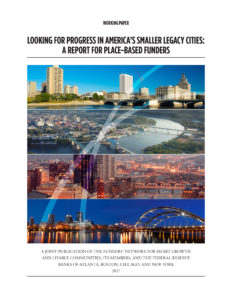As part of our ongoing work exploring the lessons and recommendations offered in Looking for Progress in America’s Smaller Legacy Cities: A Report for Place-based Funders, we asked some of the participants in the study: How has revitalization proceeded in your community, and how might your foundation and local partners ensure that economic growth and economic opportunity develop in a coordinated fashion? Dr. Les Garner, Jr., president and CEO of the Greater Cedar Rapids Community Foundation, shares his thoughts:
The Looking for Progress report highlights the observation that revitalization in smaller legacy cities seems to move along two distinct paths: an “arc of growth,” traditionally seen as the purview of business, economic development commissions, and chambers of commerce, with the support of government; and an “arc of opportunity,” often seen as the responsibility of workforce development and K-12 educational systems, with the support of social service organizations.
In Cedar Rapids, we have recognized that revitalization must proceed in a way that ensures both economic growth and opportunity growth. Creative Corridor Rising, our current regional planning effort, is designed, in part, to bring the two arcs together.
The regional planning process has always included stakeholders invested in both the economic growth arc and the opportunity growth arc. Leadership of the process includes the business and economic development communities, higher education, our council of governments and the charitable sector as represented by the United Way of East Central Iowa and the Greater Cedar Rapids Community Foundation. Public education and area nonprofits have been at the table from the beginning.
The plan will address regional workforce development and issues of community development as well as regional economic development. The regional approach is critical in planning for the economic growth arc. As we consider those sectors that are most likely to experience rapid economic growth, we are searching for ways to merge intellectual capital from the University of Iowa with the manufacturing and production abilities of Cedar Rapids.
The arc of opportunity will certainly, but not exclusively, be addressed in the workforce development and community development sections of the plan. Issues under current discussion include removing barriers to workforce participation, enhancing affordable housing, and improving transportation. Issues related to early childhood and education achievement are being addressed, as are issues related to diversity and economic, social and cultural inclusion.
As a place-based funder, the Greater Cedar Rapids Community Foundation recognizes the important role that local nonprofits play in supporting both arcs. Many nonprofit organizations have adopted innovative approaches to addressing important components of the growth and opportunity arcs, including job training, family stability, affordable housing, health care, micro lending and the development of core neighborhoods. Along with other funders, we need to serve as a convener for conversations designed to pinpoint critical missing program elements and find the best way to use our limited resources and leverage private philanthropy to achieve a prosperous and equitable community.
A good example of the opportunities we will seek as the planning process proceeds is the work currently underway in the Wellington Heights neighborhood of Cedar Rapids. Wellington Heights is a core neighborhood that was, several years ago, considered to be at the “tipping point” of instability. Four Oaks, a family services agency, decided to focus energy on the neighborhood through its Total Child initiative. Total Child made the commitment to work with children from youth to adulthood and to support families through a variety of interventions, including making major investments in stabilizing housing in the neighborhood, an effort supported by other agencies including Habitat for Humanity. Jane Boyd Community House, an affiliate of Four Oaks, initiated the Paths Program to provide job training, coaching and advocacy for parents who faced barriers to entry into the workforce. It has subsequently partnered with corporate partner Go Daddy to establish a neighborhood-based entrepreneurial development program. The entrepreneurs who complete this program will find opportunities for financing through MICRO, the City’s micro lending program targeted to core neighborhoods. The Community Foundation convened the partners to establish MICRO, which is funded in part through private contributions. It has also funded Total Child and the Paths program. It will continue to seek such opportunities to help its nonprofit partners provide more comprehensive support for economic inclusion.
 About the author: Dr. Les Garner, Jr., is president and & CEO of the Greater Cedar Rapids Community Foundation.
About the author: Dr. Les Garner, Jr., is president and & CEO of the Greater Cedar Rapids Community Foundation.
 Looking for Progress in America’s Smaller Legacy Cities: A Report for Place-based Funders
Looking for Progress in America’s Smaller Legacy Cities: A Report for Place-based Funders
As part of The Funders’ Network-Federal Reserve Philanthropy Initiative, the Federal Reserve Banks of Atlanta, Boston, Chicago, and New York recently released, in partnership with The Funders’ Network, a whitepaper presenting findings from a four-city study tour of older, legacy cities. This blog is the second in an occasional series stemming from that report. The full report can be downloaded here.
Main photo credit: Iowa’s Creative Corridor.
